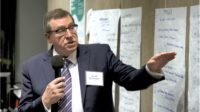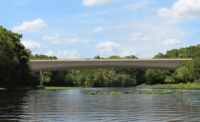With Miami the setting for its 2019 convention, the American Society of Civil Engineers unveiled an initial proof-of-concept vision for a sea-based “Floating City,” one of five concepts included within the association’s Future World Vision: Infrastructure Reimagined project.
The project, which ASCE established as a separate entity known as FWV Inc., represents a four-year commitment by the organization. In a report released earlier this year announcing early analysis from the effort, ASCE stated that Future World Visions “mapped out key trends and potential outcomes and analyzed a range of plausible future-based scenarios to model how society might interface with cities, infrastructure and operational systems, while also illustrating what civil engineers must do to develop solutions for the changing future.”
Using six key, long-term trends—climate change, alternative energy, high-tech construction/advanced materials, autonomous vehicles, smart cities, and policy and funding—ASCE created five Future World concepts: Mega City, Rural City, Floating City, Frozen City and Offworld City.
To Gerald Buckwalter, ASCE’s chief operating and strategy officer, the Future Worlds project is an important step for the engineering community to begin to plan for a rapidly changing world.
“There’s a convergence of some significantly disruptive trends occurring that, in combination, will probably cause more change to the engineering profession and to built infrastructure in the next 50 to 100 years than we’ve seen in over a thousand years,” Buckwalter told Engineering News-Record at the convention, held earlier this month. The effort will position ASCE to serve as a “thought leader” on this topic, he added.
ASCE hired Alex McDowell, of Experimental Design Inc., who previously served as production designer for the futuristic sci-fi film “Minority Report,” to lead the project’s conceptualizing. McDowell then led a team that incorporated input from dozens of subject-matter experts to create a digital model envisioning the detailed development of these city concepts up to 50 years into the future.
By creating five different prototypes, Buckwalter says, it’s possible to identify the implications for civil engineering that are common among all of the future scenarios.
“This will allow us to discover the durability of some of our tools and practices now, and some things that are just going to have to be different, and give us plenty of runway to figure that out” he says.
Surely hoping for considerable “runway” for long-term planning was Miami Mayor Francis X. Suarez (R), who was on hand to offer a response to McDowell’s unveiling of the Floating City.
In news related to the trends of climate change and rising sea levels envisioned by ASCE’s Floating City concept, Suarez reported that the city had just one day prior passed a resolution supporting the concept of a “carbon dividend” tax on carbon-emitting entities.
Suarez cited Miami’s interactions with the Netherlands and New Orleans as examples of how the city is planning to survive rising sea levels. “It is possible to convert water from an enemy into an asset,” he said. “That’s what we’re going to seek to do as we move into this new future where climate is certainly one of the main factors that we need to plan for if we want to be here forever.”






Post a comment to this article
Report Abusive Comment